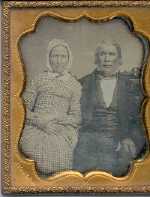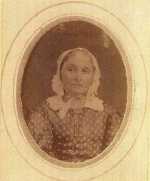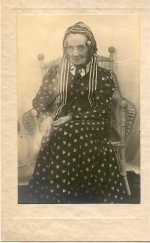Sign up for the Family Tree Newsletter Plus, you’ll receive our 10 Essential Genealogy Research Forms PDF as a special thank you!
Get Your Free Genealogy Forms
"*" indicates required fields
 |
 |
 |
| Figure 1 | Figure 2 | Figure 3 |
If you were to ask a group of women about their hat-wearing habits, few if any would report wearing one except in inclement weather. While you probably don’t wear a hat and may not even own one, for generations of American women, a hat completed an outfit.
Several of my columns feature hats as a key element for establishing a date for a photograph, but there is a type of headgear I haven’t talked about—daycaps. While they appear in many of the photographs submitted for identification, they are barely mentioned in resources covering costume history. Here are three photographs of women wearing daycaps. Figure 1 is a daguerreotype and the other two are paper prints. Take a look at the different caps worn by the women in these photographs and send me more. I’d love to continue researching these caps.
Basically, women wore daycaps everyday and for special occasions. The style variations depended on the time period, but all were made from sheer starched white cotton fabric or linen. Daycaps appear in photographs taken in the 1840s. A woman could wear an outdoor hat of fabric or straw over the cap so that when she removed the outside layer, her cap was still part of her outfit. Women wore them with a frilled brim folded in half and set back on the head. Young women usually did not tie the strings while older women did (though I’ve seen photographs of older women with untied strings). Most caps had a full puffed crown. By the 1850s, patterns for caps continued to appear in women’s magazines, but these were for home use. These caps had lengthy wide ties edged with lace. When you see them in photographs, generally older women or invalids are wearing them.
Figure 1 is a traditional style of cap. It has a puffed crown, with the brim folded back although worn low on the head. This woman chose to tie it under her chin. The owner of the image, Doug Gordon, thinks the woman is his great-great-grandmother, Clarissa Berry Loyd (1808-1870), pictured with his great-great-grandfather Peter Gordon (1800-1853). Peter and Clarissa were born and lived in Maysville, Ky. If this is the Gordons, then it was taken before 1853. The style of the daguerreotype and their clothing definitely dates from the late 1840s to 1853. The puzzling part of the image is their ages. In 1853 Peter Gordon would have been 53 years old and his wife 45. While individuals age at different rates due to heredity, lifestyle and illness, it is difficult to imagine that these two people are not older. Unfortunately, Peter Gordon’s parents were dead in the early 1840s and that fact eliminates them from consideration. This currently remains a Gordon family mystery.
Figure 2 may be a photograph of Maria Grace Ackley (1807-1887) who was born in Philadelphia and died in Noble County, Ohio. Her cap is set back on her head, with a folded brim trimmed with lace and tied under the chin. Once again, this is an older woman. She signifies her age by wearing a cap. Her full sleeves and wide collar date from the late 1850s. She would be about 50 and this time, she looks about the right age.
Figure 3 is an unknown woman wearing an unusual cap. The caption on the back of the image states “Old lady died 103” with no details. Her dress features a stand-up collar with full sleeves on the upper arm. Her cap features dark and light stripes with long trim and a great deal of frill around the brim. She wears it tied. Her dress dates from the early 1890s, but her cap is an earlier style. Older women often wore outdated cap styles into their advanced years. While caps are not always reliable for dating a photograph they can help establish a woman’s sense of fashion. I love the expression on this woman’s face. She posed for the camera with a smirk, as if she knew the cap on her head defied all fashion sense. Widows usually wore black caps as a sign of mourning, but I’ve never seen a black and white striped cap like this in any photograph or even mentioned by costume historians.
Note to readers: Figures 2 and 3 were submitted to this column a year ago. If you’ve sent me a photograph for identification and haven’t seen it featured, send me a quick note with your updated e-mail address. I was unable to contact the owners of these two images because their e-mail addresses are no longer valid. Please stay in touch.
Find out how to submit your own picture for possible analysis by Maureen Taylor. E-mail her at mtaylor@taylorandstrong.com.
ADVERTISEMENT

